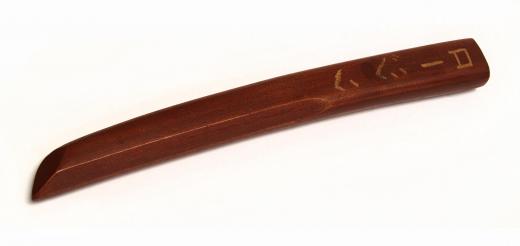Aikido weapons include a wooden sword, called a bokken; a short staff, called a jo; and a knife, called a tanto. The bokken, jo and tanto have been used in aikido training since it was founded in the 1920s by Morihei Ueshiba. Ueshiba wanted to create a type of martial arts that would use the momentum of attackers against them. This is similar to the philosophy behind jujitsu. In keeping with its emphasis on defense over offense, aikido weapons training does not focus on teaching practitioners how to attack with weapons, but on how to defend themselves in the event of being attacked. Training for disarming attacks by firearm has also been implemented in some aikido schools.
A bokken is a wooden sword used in aikido weapons training. It is intended purely for training purposes and is not considered too reliable in an actual combat scenario. Its length is usually around 40 inches (101.6 centimeters), similar to the size of a katana—a Japanese samurai sword—or a shinai, a bamboo sword used in kendo training. There are shorter variations of bokkens meant to imitate different lengths of swords. Bokkens are made from a variety of wood, such as white and red Oak, Jatoba and Hickory. The school of training associated with the bokken is called aiki-ken.

The jo is another staple of aikido weapons training. The jo is a short staff. The length of the jo depends on the height of the practitioner; standing vertically, it should come up to just underneath the armpit. Like the bokken, different types of wood are used to make the jo. The school of training associated with the jo is called aiki-jo.
The third of the classic aikido weapons is the tanto, or knife. Tantos used for training are either made out of wood or plastic. The length of the blade is usually around 13 inches (33 centimeters). Techniques for knife-taking and disarming are grouped under the taijitsu school of training.

Aikido weapons training instructs practitioners to use the momentum of the attacker against them. This results in slower, open-handed movements. As such, it generally takes longer before aikido practitioners feel comfortable enough to use their training in actual combat scenarios. Other, more offensive-minded martial arts might be better suited for quickly learning applicable self-defense skills. Jujitsu is similar to aikido, which also teaches practitioners to take advantage of the attacker's movements. With its slow and patient form, aikido is also well-suited for spiritual meditation, and is often practiced for that purpose.
